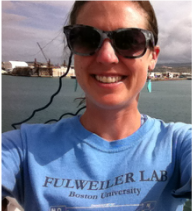 SQF leaving the port in Honolulu. SQF leaving the port in Honolulu. First day of our research cruise to Station Aloha. We got underway at 9am this morning and we have been making our way up the western coast of Oahu. We just past the most western point of the island and are heading north leaving the land behind us. What a beautiful day! I wish I could take a picture that captured how blue the water is! Our day started with safety training and drills with the captain of the R/V Kilo Moana. Later in the morning we did a test CTD deployment and cast. The CTD is a submersible instrument that measures Conductivity (salinity), Temperature, and Depth as it is lowered through the water column. Attached to the CTD are other sensors that measure light, water clarity, dissolved oxygen, nitrate, and fluorescence (measure of chlorophyll a which is a proxy for phytoplankton biomass). After the cast, my group ("The Kraken") prepped the sediment trap tubes (see the second pic). These will deployed tonight at midnight and they will be collected in 5 days. They will capture the "stuff" (sometimes referred to as marine snow) that falls through the water column. We can measure the carbon and nutrient content of this material and it will give us a sense of what type of material is being transported from the upper part of the water column to the lower depths. This is important because the marine snow is a food source for many sea creatures. A very small portion of these particles may make it to the bottom of the sea where it may be consumed or buried. The movement of carbon (found in marine snow) from the surface of the ocean to the interior of the sea is called the biological pump. This pump plays an important role in global carbon cycle.
2 Comments
Leave a Reply. |
Sarah Q. FosterSarah is a 2nd year Ph.D. student in the Fulweiler Lab. This blog documents her experience taking a summer course "Microbial Oceanography: From genome to biome" at C-MORE at the University of Hawai'i at Manoa. ArchivesCategories |

 RSS Feed
RSS Feed